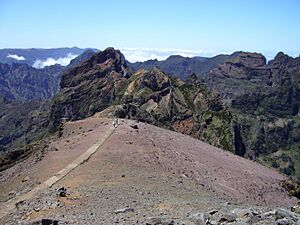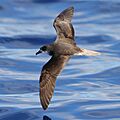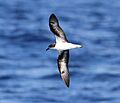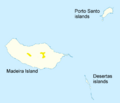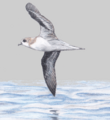Zino's petrel facts for kids
Quick facts for kids Zino's petrel |
|
|---|---|
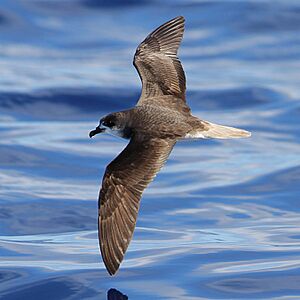 |
|
| View of upperparts | |
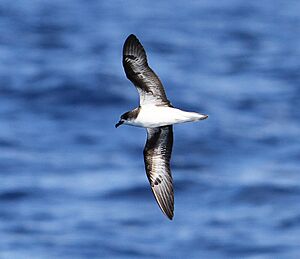 |
|
| View of underparts | |
| Conservation status | |
| Scientific classification | |
| Genus: |
Pterodroma
|
| Species: |
madeira
|
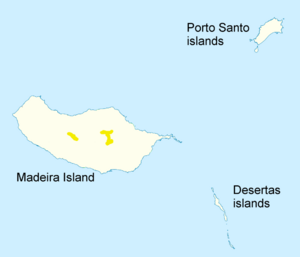 |
|
|
Nesting areas (winters at sea)
|
|
| Synonyms | |
|
Pterodroma mollis madeira |
|
The Zino's petrel (Pterodroma madeira), also called the freira, is a small seabird. It belongs to the gadfly petrel family and lives only on the island of Madeira. This bird has long wings and a grey back. Its wings show a dark "W" shape, and its upper tail is grey. The underside of its wings is mostly blackish, but there's a white triangle near its body. Its belly is white with grey sides.
Zino's petrel looks very much like the slightly larger Fea's petrel. It is very hard to tell these two birds apart when they are flying over the ocean. Zino's petrel used to be thought of as a type of soft-plumaged petrel. However, scientists found out they are not closely related. They are now considered a separate species because of differences in their looks, calls, and breeding habits. This bird is one of Europe's most endangered seabirds. It nests only on a few high ledges in the central mountains of Madeira.
Zino's petrels nest in burrows and only visit them at night. They make haunting calls in the dark. Both parents take turns sitting on the single white egg. One parent stays on the nest while the other hunts for fish and squid at sea. In the past, cats, rats, and even local shepherds hunted these birds. Thanks to efforts to control predators and protect their nests, the population has grown. There are now about 65–80 breeding pairs. Even so, the species is still listed as endangered. In 2010, a fire killed many chicks and some adult birds. But the population recovered and was stable by 2018.
Contents
About Zino's Petrel
Zino's petrel is part of a group of seabirds called gadfly petrels. These birds live in warm and tropical oceans. Many of them are not well known, and they often look very similar. This has made it tricky for scientists to classify them.
How Scientists Classified This Bird
Birds living in the Macaronesian islands (Madeira, Bugio, and Cape Verde) were once thought to be types of the soft-plumaged petrel. But studies of their DNA, size, calls, and breeding habits showed they were different. Scientists now believe the Bermuda petrel might be their closest relative.
In 2003, experts agreed that Zino's petrel and Fea's petrel should be full species. Scientists think these two Macaronesian species became separate about 850,000 years ago.
What We Learn from Bird Lice
Scientists studied tiny lice found on Fea's petrels and Zino's petrels. They found big differences in the types of parasites each bird carried. This suggests the two bird species have been separate for a long time. Lice usually only spread when birds touch each other in the nest.
The lice on Zino's petrels are most like those on the Bermuda petrel. Fea's petrel's lice are similar to those on other petrels from the Caribbean and Pacific. This might mean that Zino's petrel and Fea's petrel came from different groups of birds that settled on Madeira and the Desertas Islands.
Naming the Zino's Petrel
A German naturalist first recorded these petrels in Madeira in 1903. However, he did not realize they were different from Fea's petrels. In 1934, an Australian bird expert named Gregory Mathews officially described them.
The species was named after Paul Alexander Zino, a British bird expert. He worked hard to protect these birds in the late 1900s. The name Pterodroma comes from Greek words meaning "wing" and "running." This describes the bird's fast, zig-zag flight. The specific name madeira refers to the island where it breeds.
The Portuguese name Freira means "nun." People from a nearby valley called Curral das Freiras believed the petrels' calls at night were the sounds of suffering nuns. These nuns had hidden in the valley during pirate attacks in 1566.
What Zino's Petrel Looks Like
This petrel is about 32 to 34 centimeters (12.6 to 13.4 inches) long. Its wingspan is about 80 to 86 centimeters (31.5 to 33.9 inches). It weighs around 290 grams (10.2 ounces). It has a grey back and grey wings with a dark "W" pattern. Its upper tail is also grey.
The underside of its wings is blackish, except for a white triangle near its body. Its belly is white with grey sides. The head has a mottled whitish-brown forehead and a dark cap. There is a dark spot below and behind its brown eye. Its bill is black, and its legs are pink. The front part of its feet is pink, while the rest of its toes and webs are black-brown.
Zino's petrel flies fast, especially in strong winds. It soars high with angled wings. We do not know much about how young birds look or how they change their feathers. This makes it hard to tell their age.
How to Tell Zino's Petrel from Fea's Petrel
Zino's petrel is smaller than Fea's petrel. This size difference can be hard to see at sea. Zino's petrel has a small, delicate, and often slender bill. This is clearer in birds with very thin bills, which are usually females.
Another helpful sign is a large whitish area on the underside of its wing. Only about 15% of Zino's petrels show this feature. Zino's petrel also has a more rounded wing tip. However, some Fea's petrels can also have rounded wing tips, so this is not always a clear sign.
What Zino's Petrel Sounds Like
At its breeding sites, Zino's petrel makes a long, sad call. It sounds like the hooting of a tawny owl. It also sometimes makes a whimpering sound like a puppy. It is silent when it is at sea. Its breeding calls are very similar to those of Fea's petrel.
Where Zino's Petrel Lives
Zino's petrel lives only on the main island of Madeira. It nests on hard-to-reach ledges in the central mountains. These ledges are between Pico do Arieiro and Pico Ruivo. The plants on these ledges are special types of plants found only there. It nests at heights above 1,650 meters (5,413 feet).
This bird used to live in more places. Fossils have been found in a cave in eastern Madeira and on nearby Porto Santo Island. The breeding ledges must be places that introduced goats cannot reach. This helps keep the special plants growing there. The plants also help create enough soil for the birds to dig their nests. Goats trampling the ground would reduce the soil.
Where Zino's Petrel Goes at Sea
This petrel is only in Madeiran waters during its breeding season. We do not know much about where it goes the rest of the year. This is because the species is rare and hard to tell apart from other petrels at sea. Birds thought to be Zino's or Fea's petrels have been seen on both sides of the North Atlantic Ocean.
More sightings have been reported in Ireland and Britain. This might be because global warming is bringing more tropical birds to cooler waters. The timing of these sightings suggests the birds might fly in a clockwise circle around the North Atlantic after breeding. However, the few birds identified for sure have all been Fea's petrels. Zino's petrel might do something similar. Early studies show they spread out over the North Atlantic during breeding season. They then migrate towards the Brazilian coast when not breeding.
Life Cycle and Behavior
Reproduction and Nesting Habits
Zino's petrels breed two months earlier than Fea's petrels. They return to their breeding grounds in late March or early April. They court each other over the nesting area in the late evening and early morning. Their nest is a shallow burrow or an old rabbit tunnel. It can be up to 140 centimeters (55 inches) long. They dig these tunnels in thick soil on vegetated ledges. Older pairs tend to make longer tunnels.
The oval white egg is laid from mid-May to mid-June. It is placed in a chamber at the end of the burrow. Both parents take turns incubating the egg for 51–54 days. One parent sits on the nest while the other feeds at sea. The young birds leave the nest about 85 days later, in late September and October.
This petrel is very careful to be active only at night at its breeding sites. This helps it avoid predators like gulls. It stays 3–5 kilometers (1.9–3.1 miles) offshore during the day. It comes to land only after dark. It calls from about 30 minutes after nightfall until dawn, even on moonlit nights.
Family Life
Zino's petrels mate for life. Pairs return to the same burrow year after year. If they lose their single egg, they do not lay another one that year. These birds live a long time. One bird was seen returning to its burrow for ten years in a row. Their lifespan is estimated to be about 16 years. We do not know when they first start breeding, but it is thought to be at four years old or more.
Even though their breeding sites are close, Zino's and Fea's petrels have never been found nesting together. Zino's petrel is not known to breed with any other species.
What Zino's Petrel Eats
Like its relatives, Zino's petrel eats small squid and fish. Scientists found that one bird's stomach contents included cephalopods, glowing fish, and small crustaceans. Like other small petrels, Zino's petrel usually does not follow ships.
Who Hunts Zino's Petrel?
Because Zino's petrels approach their nests at night, they avoid gulls and daytime birds of prey. The only owl on Madeira hunts rodents, not birds. Madeira has no native land mammals other than bats. However, there are introduced animals that hunt birds or chicks. These include brown rats and wild domestic cats. Even the high mountain nests are not safe from these clever predators. In 1990, cats killed ten adult birds.
Zino's petrels can also have tiny parasites called lice.
Protecting Zino's Petrel
Zino's petrel lives in a very small area on the mountaintops of one island. It is one of Europe’s most endangered seabirds. People thought these birds were extinct by the mid-1900s. Two young birds were found in Funchal in the 1940s, probably attracted by lights. But the species was not seen again until 1969.
In 1969, Paul Zino played a recording of Fea's petrel calls to a shepherd. The shepherd recognized the sound and led researchers to the remaining nesting area. Rats were eating eggs, so very few young birds survived. In 1985, no young birds survived at all.
The Freira Conservation Project started in 1986. Its goal was to help the Zino's petrel population grow. They did this by controlling rats and stopping people from disturbing the nests. After many birds were killed by cats in 1990, they started controlling cats too.
Current Status and Threats
There are now about 130–160 known adult birds (65–80 breeding pairs). They breed on only six ledges. Visitors at night and the building of a radar station might cause some disturbance. In the long term, climate change could also harm them. All nests are within 1,000 meters (3,281 feet) of the highest mountain in the breeding area.
In the past, shepherds collected nestlings for food, and egg collectors raided burrows. Today, the main threats are still rats eating eggs and chicks, and wild cats hunting adults. However, trapping has greatly reduced these threats.
Conservation Efforts
Zino's petrel is protected by the EU's Wild Birds Directive. Its breeding sites are inside the Parque Natural da Madeira national park. Land was bought around the main breeding site, and all farm animals were removed. This allowed the plants to grow back. However, breeding still only happens on ledges that animals could never reach.
The Freira Conservation Project and the national park started research and predator control in 1986. More funding from the EU in 2001 helped expand these efforts. The number of chicks surviving increased. In 2004, 29 chicks successfully left the nest. Because of this success, the species' status on the IUCN Red List was changed from "critically endangered" to "endangered" in 2004. Its population seemed stable or slowly growing until 2010.
The 2010 Fire and Recovery
A big problem happened on August 13, 2010. A forest fire swept through the breeding site. It killed three adult birds and 25 of the 38 chicks. The fire also destroyed plants and some nesting burrows. To help the 13 remaining chicks, conservationists removed dead birds and burnt plants. They also made the surviving nests stronger and put out poison bait for rats. The plan also included building artificial burrows and spreading seeds to help plants recover. By 2018, the colony had recovered. The population was stable with 160 adult birds.
Images for kids




